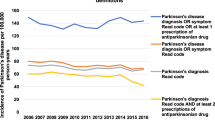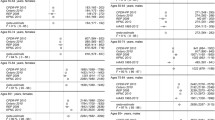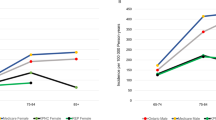Abstract
To examine time trends and the influence of socio-demographic and geographic factors on incidence of Parkinson’s disease (PD) diagnosis in a large UK population-based cohort from The Health Improvement Network (THIN), a UK primary care database. All patients aged over 50 years and contributing data to THIN between January 1999 and December 2009 were extracted and the incidence rates of PD diagnoses were determined by age, gender, time period, social deprivation score and urban/rural status. The overall incidence of PD diagnosis for people over 50 years was 84 per 100,000 person years (95 % CI 82–85). After accounting for socio-demographic factors, the adjusted incidence rates in men were 46 % higher (95 % CI 43–48 %) than in women. Adjusted incidence rates were also 12 % higher in urban than rural areas (95 % CI 4–20 %) and slightly lower in less socially deprived areas. Over time there was a downward trend in PD diagnosis with the adjusted incidence rates declining by around 6 % every calendar year (95 % CI 5–6 %) between 1999 and 2009. Broadening the definition of PD from diagnostic codes to include symptoms and antiparkinsonian drug prescriptions increased the overall incidence to 118 per 100,000 person years (95 % CI 116–120) and showed a much weaker downward trend over time of around 1 % per calendar year (95 % CI 1–2 %). With the broader definition, the adjusted incidence rates remained significantly higher in men compared to women and in urban areas compared with rural areas but not in socially deprived areas. The PD diagnosis rates in the primary care setting were, as expected, higher in men, and slightly higher in urban areas, but not different between socio-economic groups. There was a decline in PD diagnosis in the primary care setting, which may largely represent changes in diagnosis and/or coding rather than a true decline in incidence.


Similar content being viewed by others
References
de Rijk MC, Tzourio C, Breteler MM, Dartigues JF, Amaducci L, Lopez-Pousa S et al (1997) Prevalence of parkinsonism and Parkinson’s disease in Europe: the EUROPARKINSON Collaborative Study. European Community Concerted Action on the Epidemiology of Parkinson’s disease. J Neurol Neurosurg Psychiatry 62(1):10–15
Wickremaratchi MM, Perera D, O’Loghlen C, Sastry D, Morgan E, Jones A et al (2009) Prevalence and age of onset of Parkinson’s disease in Cardiff: a community based cross sectional study and meta-analysis. J Neurol Neurosurg Psychiatry 80(7):805–807
Lees AJ, Hardy J, Revesz T (2009) Parkinson’s disease. Lancet 373(9680):2055–2066
Dick FD, De Palma G, Ahmadi A, Scott NW, Prescott GJ, Bennett J et al (2007) Environmental risk factors for Parkinson’s disease and parkinsonism: the Geoparkinson study. Occup Environ Med 64(10):666–672
Dick FD, De Palma G, Ahmadi A, Osborne A, Scott NW, Prescott GJ et al (2007) Gene-environment interactions in parkinsonism and Parkinson’s disease: the Geoparkinson study. Occup Environ Med 64(10):673–680
Biskup S, Gerlach M, Kupsch A, Reichmann H, Riederer P, Vieregge P et al (2008) Genes associated with Parkinson syndrome. J Neurol 255(Suppl 5):8–17
Hancock DB, Martin ER, Stajich JM, Jewett R, Stacy MA, Scott BL et al (2007) Smoking, caffeine, and nonsteroidal anti-inflammatory drugs in families with Parkinson disease. Arch Neurol 64(4):576–580
Kuopio AM, Marttila RJ, Helenius H, Rinne UK (1999) Changing epidemiology of Parkinson’s disease in southwestern Finland. Neurology 52(2):302–308
Tandberg E, Larsen JP, Nessler EG, Riise T, Aarli JA (1995) The epidemiology of Parkinson’s disease in the county of Rogaland, Norway. Mov Disord 10(5):541–549
Peters CM, Gartner CE, Silburn PA, Mellick GD (2006) Prevalence of Parkinson’s disease in metropolitan and rural Queensland: a general practice survey. J Clin Neurosci 13(3):343–348
Chen CC, Chen TF, Hwang YC, Wen YR, Chiu YH, Wu CY et al (2009) Different prevalence rates of Parkinson’s disease in urban and rural areas: a population-based study in Taiwan. Neuroepidemiology 33(4):350–357
Booth N (1994) What are the Read Codes? Health Libr Rev 11(3):177–182
Townsend P (1986) Inequalities in health in the northern region : an interim report. University of Bristol, Bristol
Bourke A, Dattani H, Robinson M (2004) Feasibility study and methodology to create a quality-evaluated database of primary care data. Inform Prim Care 12(3):171–177
Maguire A, Blak BT, Thompson M (2009) The importance of defining periods of complete mortality reporting for research using automated data from primary care. Pharmacoepidemiol Drug Saf 18(1):76–83
Horsfall L, Walter K (2012) Petersen I. Identifying periods of acceptable computer usage in primary care research databases, Pharmacoepidemiol Drug Saf
Lewis JD, Bilker WB, Weinstein RB, Strom BL (2005) The relationship between time since registration and measured incidence rates in the General Practice Research Database. Pharmacoepidemiol Drug Saf 14(7):443–451
Dave S, Petersen I (2009) Creating medical and drug code lists to identify cases in primary care databases. Pharmacoepidemiol Drug Saf 18(8):704–707
Priyadarshi A, Khuder SA, Schaub EA, Priyadarshi SS (2001) Environmental risk factors and Parkinson’s disease: a metaanalysis. Environ Res 86(2):122–127
Lix LM, Hobson DE, Azimaee M, Leslie WD, Burchill C, Hobson S (2010) Socioeconomic variations in the prevalence and incidence of Parkinson’s disease: a population-based analysis. J Epidemiol Community Health 64(4):335–340
MacDonald BK, Cockerell OC, Sander JW, Shorvon SD (2000) The incidence and lifetime prevalence of neurological disorders in a prospective community-based study in the UK. Brain 123(Pt 4):665–676
van de Vijver DA, Roos RA, Jansen PA, Porsius AJ, de Boer A (2001) Estimation of incidence and prevalence of Parkinson’s disease in the elderly using pharmacy records. Pharmacoepidemiol Drug Saf 10(6):549–554
Rait G, Walters K, Griffin M, Buszewicz M, Petersen I, Nazareth I (2009) Recent trends in the incidence of recorded depression in primary care. Br J Psychiatry 195(6):520–524
Rocca WA, Bower JH, McDonnell SK, Peterson BJ, Maraganore DM (2001) Time trends in the incidence of parkinsonism in Olmsted County, Minnesota. Neurology 57(3):462–467
Van Den Eeden SK, Tanner CM, Bernstein AL, Fross RD, Leimpeter A, Bloch DA et al (2003) Incidence of Parkinson’s disease: variation by age, gender, and race/ethnicity. Am J Epidemiol 157(11):1015–1022
Twelves D, Perkins KS, Counsell C (2003) Systematic review of incidence studies of Parkinson’s disease. Mov Disord 18(1):19–31
Adams J, Ryan V, White M (2005) How accurate are Townsend Deprivation Scores as predictors of self-reported health? A comparison with individual level data. J Public Health 27(1):101–106
Krieger N, Williams DR, Moss NE (1997) Measuring social class in US public health research: concepts, methodologies, and guidelines. Annu Rev Publ Health 18:341–378
Grundy E, Holt G (2001) The socioeconomic status of older adults: how should we measure it in studies of health inequalities? J Epidemiol Community Health 55(12):895–904
Conflict of interest
The authors declare that they have no conflict of interest. This research received no specific grant from any funding agency in the public, commercial or not-for-profit sectors. Therefore, there is no financial relationship with a sponsoring organization.
Author information
Authors and Affiliations
Corresponding author
Rights and permissions
About this article
Cite this article
Horsfall, L., Petersen, I., Walters, K. et al. Time trends in incidence of Parkinson’s disease diagnosis in UK primary care. J Neurol 260, 1351–1357 (2013). https://doi.org/10.1007/s00415-012-6804-z
Received:
Revised:
Accepted:
Published:
Issue Date:
DOI: https://doi.org/10.1007/s00415-012-6804-z




